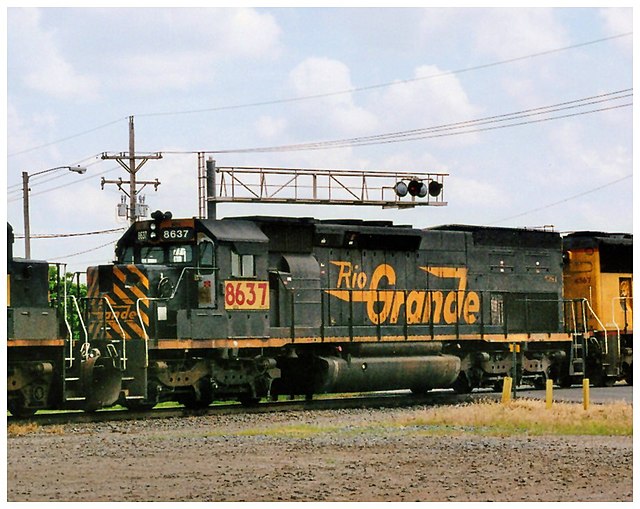Narrow-gauge railroads in the United States
Standard gauge was favored for railway construction in the United States, although a fairly large narrow-gauge system developed in the Rocky Mountains of Colorado and Utah. Isolated narrow-gauge lines were built in many areas to minimize construction costs for industrial transport or resort access, and some of these lines offered common carrier service. Outside Colorado, these isolated lines evolved into regional narrow-gauge systems in Maine, New York, Pennsylvania, Ohio, Iowa, Hawaii, and Alaska.
The Maine Narrow Gauge Railroad in Portland, Maine
East Broad Top's rare gas-electric railcar M-1
A steam locomotive of the C&TS RR
Shay geared locomotive at the Roaring Camp and Big Trees Narrow Gauge Railroad
Denver and Rio Grande Western Railroad
The Denver and Rio Grande Western Railroad, often shortened to Rio Grande, D&RG or D&RGW, formerly the Denver & Rio Grande Railroad, was an American Class I railroad company. The railroad started as a 3 ft narrow-gauge line running south from Denver, Colorado, in 1870. It served mainly as a transcontinental bridge line between Denver and Salt Lake City, Utah. The Rio Grande was also a major origin of coal and mineral traffic.
During the late 1800s the D&RG made extensive use of consolidations (engines with a 2-8-0 wheel arrangement). This drawing, of an unusual wheel arrangement, was titled "Standard Consolidation Engine," 1881.
Over the course of decades, D&RG consolidations were subjected to various modifications. In the 20th century, diamond stacks gave way to straight stacks, box headlights were replaced with round ones, decorative trim disappeared from the domes, and wooden pilots (cowcatchers) were replaced with steel ones.
D&RGW 5384, patch-renumbered into UP 8637
D&RGW passenger train at the Colorado Railroad Museum. The F9 A&B diesel electric locomotives (1955) were used for the California Zephyrs and Rio Grande Zephyrs.








